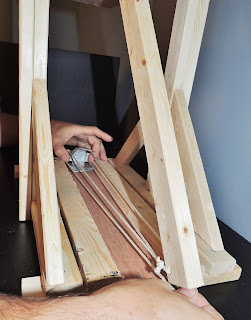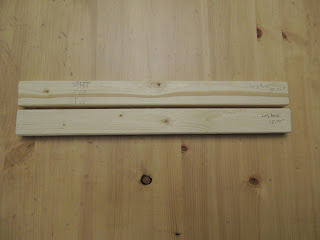Trebuchet Instructions
Main Supplies:
(3) Three 1x2x8 boards (that is what the tag says but actual measurement is smaller) - the boards were $1.17 each ($3.51). I had about 20 inches of wood left over after all cutting was done.
(1) One Wooden Dowel (7/16in x 48in) - ($1.78)
(3) Three packs of #6 x 1 ¼ in wood screws (10 in each pack = total 30 screws - only 2 pictured here)
(each pack was $1.24 which cost 3.72 or you could buy 100 pack for $4.57 and split with another Trailman)
1- #6 - 1/2 inch screws ($1.24)
1 - 2" x 16" piece of flat board and 1 6"x 6" piece of flat board. Here I bought a $4 piece which gave me an excess amount (could split with another Trailman) and I had to cut to size but there are smaller options out there at both hardware stores and craft stores
**Total supply cost for build was $12.47
Tools Needed:
Miter Box and Saw
Drill and Phillips Head screw Driver Bit
Measuring Apparatus (tape or yard stick)
1 Bottle wood glue
Some notes about the build:
1. I came up with this plan so it could be made with simple and inexpensive tools. All cuts were made with the miter box except when trimming the thin board later in the project.
2. I did not sand edges in this demonstration to save time but I highly recommend you do this.
3. I did not show drilling pilot holes for screws but this was done as well.
Ok - Here we go!
Step 1
Once you have assembled all of the required supplies and tools;
Cut 6 pieces each 16 inches long. (You may want to measure short say 15 and 15/16th to save for blade width. I did 15.75 inches on this one.)
Step 2
Cut 2 pieces, one 10 inches long and one 9 inches long.
You can also do 3 pieces at 10 inches and it will not effect the total outcome, but I left room in this one on the outside as you will see.
Step 3
Create the base of the trebuchet by gluing together the 16 inch pieces length wise on top of the 10 inch pieces. Add the 9 inch pieces in the middle and at each end.
It should look like this...
If you use 3 10 inch pieces you will not see the end of the board sticking out and the edges will be flush.
Step 4
Cut 2 lengths of the dowel - one 12 inches and one 6 inches. Set aside to use later
Step 5
Making the upright supports.
Glue the other two 16 inch pieces together, leaving room as shown, to fit onto the base.
The distance is about a 1 1/2" difference at the top and bottom as shown. It is best to measure as shown in the second picture before gluing.
Glue the pieces together as shown in pictures 3 and 4
Repeat this procedure for the other side.
Step 6
Once the glue has dried, drill a hole into one end of the supports as shown.
The hole needs to be big enough to fit the dowel.
The side with the hole will be the top of the support.
Step 7
Glue the supports in place, and screw also them into place for added support
(It is helpful to have the 12 inch dowel in place between the two supports to ensure proper placement)
Step 8
Cut 4 - 10 inch pieces with a 45 degree angle cut as shown below.
Glue and screw them into place. These are the braces for the supports.
Step 9
Now to make the counterweight box.
Cut 2 - 6¼ ” pieces and 2 - 3 ¾ “ pieces which will become the frame for the counter weight box.
Glue and screw them together as shown.
Step 10
Cut 2 – 8 ½ ‘” pieces.
1 ½ inch from one end of each piece, drill a hole that is an appropriate size to fit your dowel.
With dowel in place between the two upright supports, glue and screw the brace supports into the middle of the box as shown with the drilled holes and with the 6 inch dowel in place to ensure proper position.
Step 11
Finally use the 6" by 6" thin board to create the base for box and use the smaller screws to attach it. This board may need to be trimmed to fit flush.
Step 12
Creating and attaching the swing arm.
Cut a 24 inch piece and drill two holes for a dowel - one hole at 1 1/2" from one side and the other at 6 1/2" from the same side as shown.
You will also need a smaller drilled hole at the opposite end and slightly offset to one side for attaching sling. Here you see one swing arm with the sling attached and one with just the hole.
Attach the swing arm to the braces as shown using the rubber-bands to lock into place.
You will need to put 2 rubber-bands onto the dowel before sliding in the sling arm
Slide the sling arm into place, threading the dowel through the hole that is at the 6 1/2" measurement. After sliding the sling arm into place, you will need to add 2 more rubber-bands.
Finally, place 2 additional rubber-bands on the outside of the supports to lock the dowel into place
Step 13
Attaching the counter weight bucket.
Using the same method as with attaching the swing arm to the uprights, attach the bucket through the hole that was 1 1/2" from the end of the swing arm remembering where to place the rubber-bands to lock it into place.
Oops - I forgot to include how to build the shoot in the first version. Here it is.....
Step 14
Take 2 - 16 inch lengths of 1 x 2 and a 2 inch by 16 inch piece of flat board and construct as seen.
Sorry I forgot about this step. Under Making the Release Pin you will find where to put the eye hooks.
Assembly of the structure is now complete and you are ready to make and attache the sling.

















































































